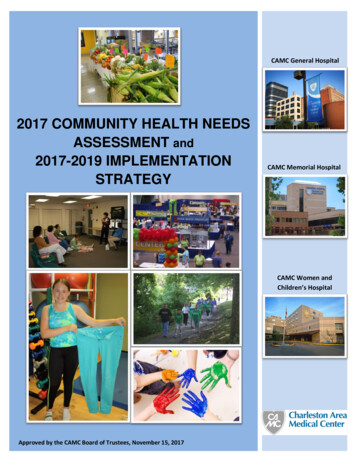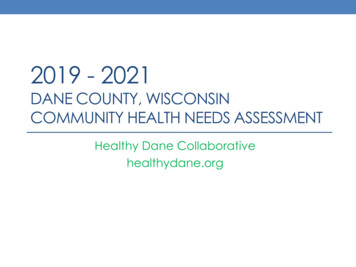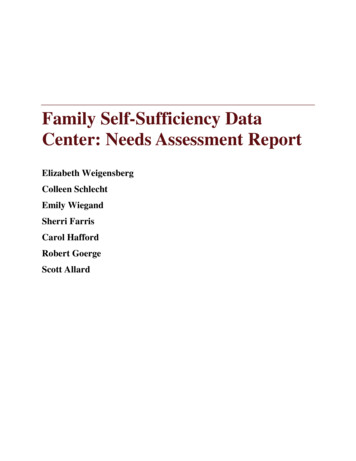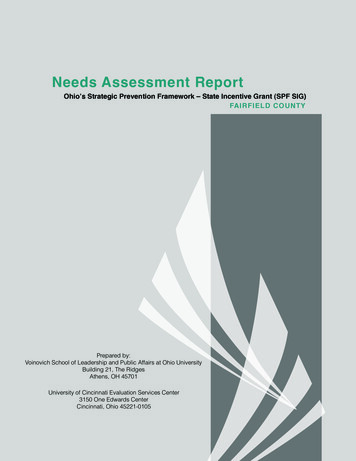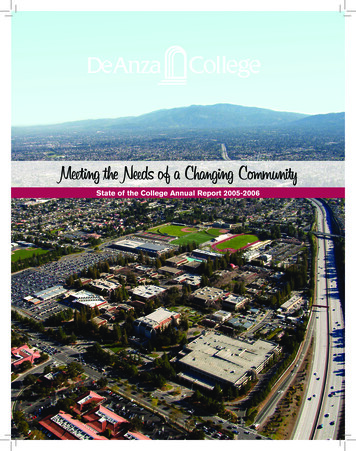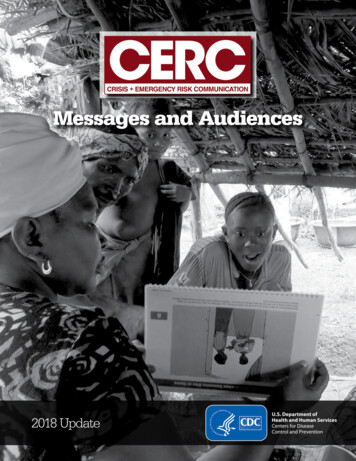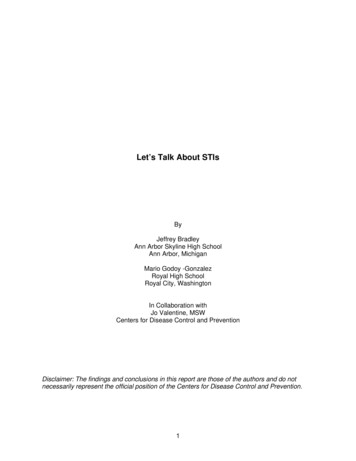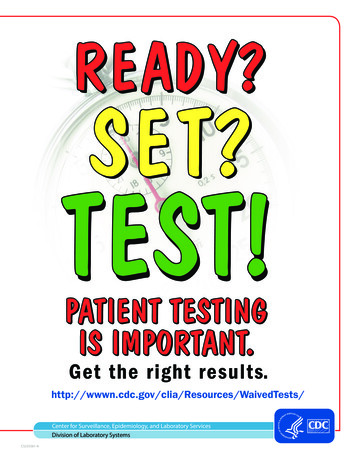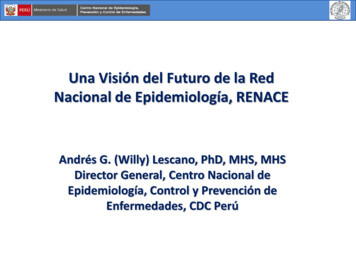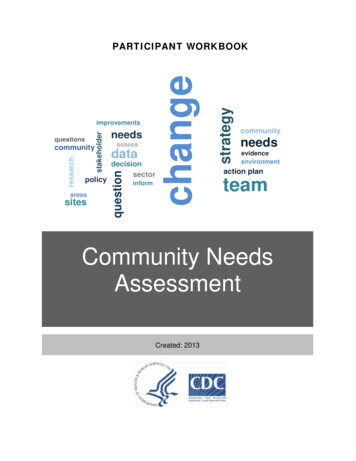
Transcription
lderimprovementschangePARTICIPANT WORKBOOKcommunityneedsevidenceenvironmentaction planteamCommunity NeedsAssessmentCreated: 2013
Community Needs Assessment. Atlanta, GA: Centers for Disease Control andPrevention (CDC), 2013.
COMMUNITY NEEDS ASSESSMENTTable of ContentsINTRODUCTION . 4LEARNING OBJECTIVES . 4ESTIMATED COMPLETION TIME . 4TARGET AUDIENCE . 4PRE-WORK AND PREREQUISITES . 4ABOUT THE WORKBOOKS . 5ICON GLOSSARY . 5ACKNOWLEDGEMENTS . 5SECTION 1: OVERVIEW OF COMMUNITY NEEDS ASSESSMENT. 6INTRODUCTION . 6CHANGE TOOL AND WORKBOOK . 8OVERVIEW OF COMMUNITY NEEDS ASSESSMENT STEPS . 8PRACTICE EXERCISE #1 (10 MINUTES) . 11SECTION 2: PLAN FOR A COMMUNITY NEEDS ASSESSMENT . 12INTRODUCTION . 12IDENTIFY AND ASSEMBLE A DIVERSE COMMUNITY TEAM . 12DEVELOP A TEAM STRATEGY . 13IDENTIFY THE SCOPE OF THE ASSESSMENT . 14DEVELOP QUESTIONS TO ASK . 17SELECT SITES. 18DETERMINE DATA COLLECTION METHODS OR USE EXISTING DATA . 18IDENTIFY KEY INFORMANTS TO CONTACT . 23DOCUMENTATION . 23PRACTICE EXERCISE #2 (30 MINUTES) . 24SECTION 3: KEY POINTS . 26SECTION 3: REVIEW AND RATE THE DATA . 27INTRODUCTION . 27POLICY AND ENVIRONMENTAL STRATEGIES . 27DEVELOP A RATING SCALE . 28MAKING A TEAM DECISION ON RATINGS . 31SECTION 4: KEY POINTS . 32SECTION 4: RECORD AND SUMMARIZE DATA . 33INTRODUCTION . 33RECORD DATA . 33SUMMARIZE DATA . 35SECTOR DATA GRID . 36PARTICIPANT WORKBOOK 2
COMMUNITY NEEDS ASSESSMENTSECTION 5: KEY POINTS . 39SECTION 5: CREATE A COMMUNITY ACTION PLAN . 40INTRODUCTION . 40IDENTIFY ASSETS AND NEEDS . 40PRIORITIZE NEEDS . 42DEVELOP STRATEGIES . 43PRIORITIZE STRATEGIES . 44COMMUNITY ACTION PLAN . 46SECTION 6: KEY POINTS . 48CONCLUSION . 49IMPLEMENTING THE ACTION PLAN AND SHARING PROGRESS . 49TAKE HOME POINTS . 50WORKBOOK REVIEW . 50RESOURCES . 51APPENDICES . 52APPENDIX A. 52APPENDIX B. 53APPENDIX C . 76PARTICIPANT WORKBOOK 3
COMMUNITY NEEDS ASSESSMENTIntroductionLEARNING OBJECTIVESAfter completion of the workbook, participants will be able to: Plan for a community needs assessment by:o Identifying a community teamo Describing the scope of the assessmento Listing the questions to asko Selecting siteso Determining data collection methods or sourceso Identifying key informants Review and rate data collected from a community needsassessment. Summarize data by creating sector data grids. Develop and prioritize strategies for improvement. Create a community action plan that includes:o Project period objectiveo Annual objective(s)o Activities needed to complete the objectiveso Persons responsible for completing the activities, ando Estimated completion timeESTIMATED COMPLETION TIMEThe workbook should take approximately 10 hours to complete.TARGET AUDIENCEThe module is designed for Field Epidemiology Training Program (FETP)residents who specialize in NCDs; however, you can also complete themodule if you are tasked to evaluate a communicable disease surveillancesystem.PRE-WORK AND PREREQUISITESBefore participating in this training module, you must complete trainingin: NCD Data Sources Program Planning Prioritizing public health problemsPARTICIPANT WORKBOOK 4
COMMUNITY NEEDS ASSESSMENTABOUT THE WORKBOOKSYou will read information about conducting a community needsassessment in the Participant Workbook. To practice the skills andknowledge learned, you will refer to the Activity Workbook and complete4 exercises.ICON GLOSSARYThe following icons are used in this workbook:Image TypeImage MeaningActivity, exercise, assessment or case study that you willcompleteActivity IconStop and consult with your facilitator/mentor for furtherinstructionStop IconResourceIconA resource or website that may provide further informationon a given topicSupplemental information, or key idea to note andrememberTip IconACKNOWLEDGEMENTSThanks to Shannon Griffin-Blake, PhD (Division of Community Health,National Center for Chronic Disease Prevention and Health Promotion,Centers for Disease Control and Prevention) for sharing and explainingthe CHANGE tool.Thanks to Indu Ahluwalia, MPH, PhD (Division of Reproductive Health,National Center for Chronic Disease Prevention and Health Promotion,Centers for Disease Control and Prevention) for reviewing this module andproviding feedback and guidance.PARTICIPANT WORKBOOK 5
COMMUNITY NEEDS ASSESSMENTSection 1: Overview of CommunityNeeds AssessmentINTRODUCTIONWhat is a “Community?”Communities are typically defined by a geographic area; however, theycan also be based on shared interests or characteristics such as religion,race, age, or occupation. People within a community come from differentbackgrounds and have unique cultures, customs, and values. Utilizingthis wide range of ideas and wisdom is critical to assessing the communityneeds and strategizing areas for improvement. Before you conduct acommunity needs assessment you should have a clear understanding ofthe different cultural groups within a community and how to best work withthem to solve the community issues.What is a Community Needs Assessment?A community needs assessment provides community leaders with asnapshot of local policy, systems, and environmental change strategiescurrently in place and helps to identify areas for improvement. With thisdata, communities can map out a course for health improvement bycreating strategies to make positive and sustainable changes in theircommunities.Components of a Needs AssessmentThe main outcomes of a community needs assessment are in 3 maincategories: Policy Change, Systems Change, and Environmental Change.Policy ChangeThis involves laws, regulations, rules, protocols, and procedures that aredesigned to guide or influence behavior. Policies can be either legislativeor organizational. Policies often mandate environmental changes andincrease the likelihood that they will become institutionalized orsustainable. Examples of legislative policies include taxes on tobaccoproducts, provision of county or city public land for green spaces orfarmers’ markets, regulations governing a national school lunch program,and clean indoor air laws. Examples of organizational policies includePARTICIPANT WORKBOOK 6
COMMUNITY NEEDS ASSESSMENTschools requiring healthy food options for all students, menu labeling inrestaurants, and required quality assurance protocols or practices (e.g.,clinical care processes).System ChangeThis involves change that affects all community components includingsocial norms of an organization, institution or system. It may include apolicy or environmental change strategy. Policies are often the drivingforce behind systems change. Examples are implementing a nationalschool lunch program across a region or provincial school system orensuring a hospital system becomes tobacco free.Environmental ChangeThis type of change relates to the physical, social, or economic factorsdesigned to influence people’s practices and behaviors. Examples ofalterations or changes to the environment include:Physical: Structural changes or the presence of programs or services,including the presence of healthy food choices in restaurants or cafeterias,improvements in the built environment to promote walking (e.g., walkingpaths), the availability of smoking cessation services to patients orworkers, and the presence of comprehensive school health educationcurricula in schools.Social: A positive change in attitudes or behavior about policies thatpromote health or an increase in supportive attitudes regarding a healthpractice, including an increase in favorable attitudes of communitydecision makers about the importance of nonsmoking policies or anincrease in nonacceptance of exposure to second-hand smoke from thegeneral public.Economic: The presence of financial disincentives or incentives toencourage a desired behavior including charging higher prices for tobaccoproducts to decrease their use or the provision of nonsmoker healthinsurance discounts.PARTICIPANT WORKBOOK 7
COMMUNITY NEEDS ASSESSMENTCHANGE TOOL AND WORKBOOKThe community needs assessment process taught in this module is based onthe Community Health Assessment and Group Evaluation (CHANGE) datacollection tool developed by CDC’s Healthy Communities Program within theDivision of Community Health at the National Center for Chronic DiseasePrevention and Health Promotion.1 The CHANGE tool was written primarilyfor communities in the United States interested in creating environments thatsupport healthy living.This workbook teaches a similar approach to conducting community needsassessment as the CHANGE tool, but since this participant workbook is to beused globally we are providing some flexibility in the tool you choose to use.For example, after learning the process you may decide to create your ownExcel spreadsheets to record and summarize data, or something similar inMS Word.ResourceIf you wish to use the CHANGE tool, you can download and modify (free ofcharge) the Excel spreadsheets at:http://www.cdc.gov/HealthyCommunitiesProgramIf you choose to order (free of charge) the CHANGE tool CD-ROM, you willalso receive additional resources such as an Action Guide, an MSPowerPoint presentation template, and a policy brief or one-pager template.Please note that the Action Guide contains slightly different “action steps”than the ones in this workbook since the workbook is designed to be usedwith or without the CHANGE tool.OVERVIEW OF COMMUNITY NEEDS ASSESSMENT STEPSThere are different approaches to conducting community needsassessments. In this module you learn how to gather and assess data oncommunity assets and determine areas for improvement. You will learn aprocess that involves these main steps:1Centers for Disease Control and Prevention. Community Health Assessment aNdGroup Evaluation (CHANGE) Action Guide: Building a Foundation of Knowledge toPrioritize Community Needs. Atlanta: U.S. Department of Health and Human Services,2010.PARTICIPANT WORKBOOK 8
COMMUNITY NEEDS ASSESSMENTThis workbook explains steps 1, 3, 4 and 5 in detail.Step 1: Plan for a community needs assessment Identify and assemble a diverse community team Develop a team strategy Define community to assess (e.g., region, village) Identify community sectors to assess (e.g., healthcare, schools) Identify community components to assess (e.g.,nutrition, tobacco) Develop questions to ask for each communitycomponent Select sites and number of sites to visit within eachsector Determine existing data to use or methods forcollecting new dataIdentify key informants to contactPARTICIPANT WORKBOOK 9
COMMUNITY NEEDS ASSESSMENTResourceStep 2: Conduct the needs assessmentFor guidance on how to conduct a needs assessment (for example,how to prepare for and conduct interviews and focus groups), accessthe North Carolina Department of Health Community AssessmentGuide Book 002/GuideBook2002.pdf.Step 3: Review and rate the data Develop a rating scale, and, Make a team decision on ratings.Step 4: Record and review consolidated data Enter the data, Total the data, and, Summarize the data.Step 5: Develop a community action plan Identify community assets and needs,Tip Prioritize needs, Develop and prioritize strategies for improvement,and, Create an action plan for top priority strategies.The focus of this workbook is on assessing a community’s strengths andweaknesses through mainly qualitative collection methods; however, it isstill important to support those findings with quantitative data collectionmethods (e.g., vital statistics, hospital records) to assess the health statusof a community; for example, identifying prevalence and incidence of NCDs.PARTICIPANT WORKBOOK 10
COMMUNITY NEEDS ASSESSMENTPRACTICE EXERCISE #1 (10 MINUTES)Instructions:1. Complete this exercise individually.ActivityThe community needs assessment can yield information about differenttypes of change strategies in the community: policy, systems orenvironmental. Systems changes can either be policy orenvironmental. Match the examples in the first column of the followingtable with the appropriate category. Mark your responses. The first onehas been done for you as an example.Example of types of strategies in a communityLaw requiring schools to provide Policyhealthy food options for studentsWalking paths at a work sitePolicyEnvironmentalEnvironmentalHigher prices for alcoholPolicyEnvironmentalSmoking cessation programs forgovernment employeesFood labelingPolicyEnvironmentalPolicyEnvironmental2. Review your responses with a colleague. Then check the answers withthose in Appendix A.Let the facilitator or mentor know you are ready for the groupdiscussion.StopPARTICIPANT WORKBOOK 11
COMMUNITY NEEDS ASSESSMENTSection 2: Plan for a Community NeedsAssessmentINTRODUCTIONPlanning for a community needs assessment is just as critical asconducting the actual assessment. You need to ensure you have the rightpeople to help out and that you have identified the logistics and content ofthe assessment, what data to collect, how to collect the data and fromwhom.In this section you will learn how to plan for a community needsassessment, in particular how to: Identify and assemble a diverse community team Develop a team strategy Identify scope of assessment Develop questions to ask Select sites Determine data collection methods Identify key informantsIDENTIFY AND ASSEMBLE A DIVERSE COMMUNITY TEAMRepresentation from diverse sectors of the community is critical tosuccessful team work and enables easy and accurate data collection andassessment. All members of the community team should have an activerole in the assessment process from developing questions to identifyingdata collection methods to use. This process also ensures the communityteam has equitable access to and informed knowledge of the process,thereby solidifying their support.Identifying 10-12 individuals is recommended to ensure the size ismanageable, allow for adequate representation of different perspectives,and to account for attrition of members. Include representatives ofdifferent stakeholder groups.Examples of types of stakeholders to include on the community team are: Law enforcer Faith leaderPARTICIPANT WORKBOOK 12
COMMUNITY NEEDS ASSESSMENT Hospital administrator Community health worker School principal or headmaster (of primary school or university) Neighborhood council representative Civic leader Local advocates Local business leader Local health practitionerWhen your community team is assembled you should clearly define thepurpose of your community team, capacity of team members and theirorganizations, identify potential barriers to success, and plan forovercoming any obstacles. Ensuring adequate funding to support thecommunity team’s efforts is critical to the success of the project.DEVELOP A TEAM STRATEGYAfter you have assembled your team you will meet to develop a teamstrategy. This involves, at a minimum: Defining goals for the needs assessment Defining how the data collected will be used (e.g., to influencepolicy makers, to support new programs, to support new changes inservice delivery or policies) Determining the timeline for the assessment (e.g., 3 months, 6months) Determining roles and responsibilities of team members Assigning tasks based on skills a
A community needs assessment provides community leaders with a snapshot of local policy, systems, and environmental change strategies currently in place and helps to identify areas for improvement. With this data, communities can map out a course for health improvement by creating strategies to make positive and sustainable changes in their

